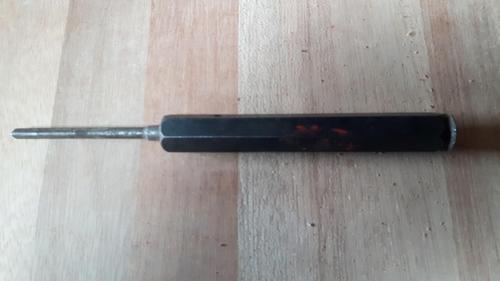Remembering Ryolith's lovely little Rapper, may I present this Rawlplug Mechanical Hammer? It was one of several desirable tools I bought at Richard Arnold's hugely successful charity day out.
How could anyone not want such a lovely combination of steel and wood?


It's pretty obvious how you use it. You slip a Rawlplug drill into the chucky end, hold the big handle, and turn the little handle round, pressing against the wall. The mechanism hits the drill bit, twists it to free the dust, then hits it again. But there are a couple of subtleties - there is a threaded spigot on the right hand side, which the handle fits. But there is a similar spigot on the other side. I wondered if something was missing, but then found that the handle has two holes. One of them has a left hand threaded hole, so it can be used on the left hand side. This means that you can work up into a corner, or just use the hand you prefer.

There is also an adjustment for how hard the hammer action is - from 'barely possible to turn the handle' through to 'too gentle to work'. On one side there is a thumbscrew and on the other side a bit of steel peeps out from a square hole.


So does it work? Yes, it does! Here is a genuine hole, drilled in the brick wall of my workshop. It's as deep as the flutes on the drill bit (about 1 1/2") and took about 30 tiring seconds to drill, into fairly soft brick.

Naturally, I wondered about the age and origin of it.
A bit of searching in the usual places threw up some pictures of this much more space-age looking Rawlpug hammer drill, seen here in my 1940 Gardiner catalogue.

This version crops up on ebay a bit, sometimes with a nice clear patent number, 396140. The number leads to this patent filed by the Rawlplug Company in 1932. Here are the drawings, which prove that Mr John Joseph Rawlings was much cleverer at imagining mechanisms than I am:

It seems likely that the two drills, so different in exterior style, have the same mechanism. I'm not planning on dismantling my drill to see if the innards are the same, but this post, on a Dutch tool collectors' site, seems to come from someone who already has.
So there's an extra oddity here. The Rawlpug company had a smart alloy model, made in England and also a much more utilitarian and old-fashioned version, made by them in Belgium. Did it fit with a particular Belgian style of toolmaking? Would it look better after a strong beer and some chips in mayonnaise?
Whatever the answers, I'm glad to have it. My first and only tool from Belgium, all ready in case I need to drill holes in a power cut.
How could anyone not want such a lovely combination of steel and wood?


It's pretty obvious how you use it. You slip a Rawlplug drill into the chucky end, hold the big handle, and turn the little handle round, pressing against the wall. The mechanism hits the drill bit, twists it to free the dust, then hits it again. But there are a couple of subtleties - there is a threaded spigot on the right hand side, which the handle fits. But there is a similar spigot on the other side. I wondered if something was missing, but then found that the handle has two holes. One of them has a left hand threaded hole, so it can be used on the left hand side. This means that you can work up into a corner, or just use the hand you prefer.

There is also an adjustment for how hard the hammer action is - from 'barely possible to turn the handle' through to 'too gentle to work'. On one side there is a thumbscrew and on the other side a bit of steel peeps out from a square hole.


So does it work? Yes, it does! Here is a genuine hole, drilled in the brick wall of my workshop. It's as deep as the flutes on the drill bit (about 1 1/2") and took about 30 tiring seconds to drill, into fairly soft brick.

Naturally, I wondered about the age and origin of it.
A bit of searching in the usual places threw up some pictures of this much more space-age looking Rawlpug hammer drill, seen here in my 1940 Gardiner catalogue.

This version crops up on ebay a bit, sometimes with a nice clear patent number, 396140. The number leads to this patent filed by the Rawlplug Company in 1932. Here are the drawings, which prove that Mr John Joseph Rawlings was much cleverer at imagining mechanisms than I am:

It seems likely that the two drills, so different in exterior style, have the same mechanism. I'm not planning on dismantling my drill to see if the innards are the same, but this post, on a Dutch tool collectors' site, seems to come from someone who already has.
So there's an extra oddity here. The Rawlpug company had a smart alloy model, made in England and also a much more utilitarian and old-fashioned version, made by them in Belgium. Did it fit with a particular Belgian style of toolmaking? Would it look better after a strong beer and some chips in mayonnaise?
Whatever the answers, I'm glad to have it. My first and only tool from Belgium, all ready in case I need to drill holes in a power cut.




































